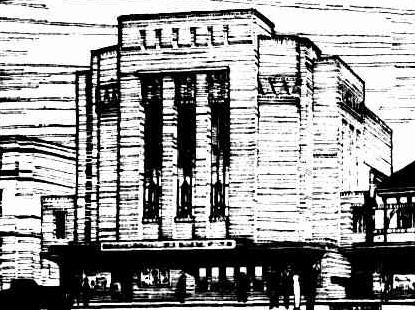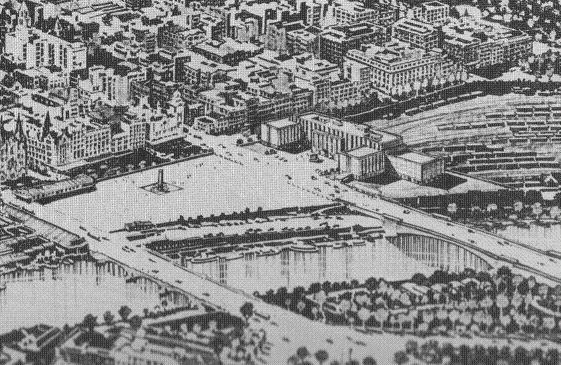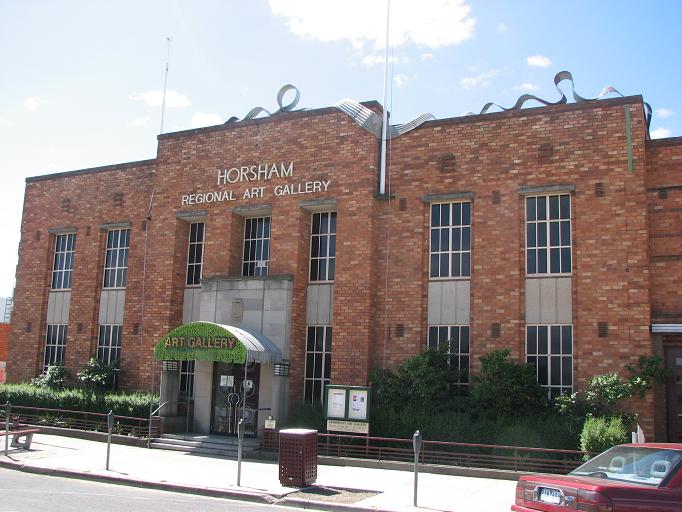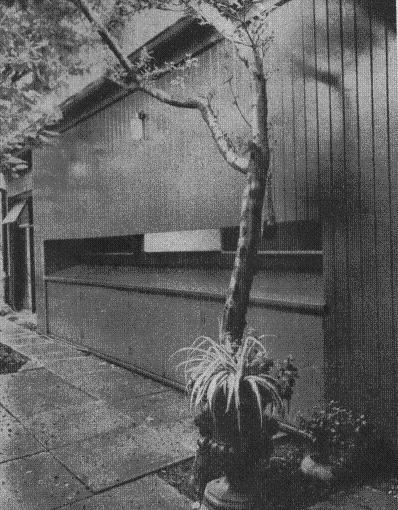The eldest child of a commercial traveller, Charles Neville Hollinshed was
born in South Kensington (London) on 8 June 1899. His
mother, Edith Marion Simmonds, hailed from New Zealand, where
she had married Charles Frederick Hollinshed in 1897. The couple
soon relocated to London, where their son was born, and thence to
Queensland, where they were to have two more children. Their
eldest, Charles Neville (who invariably referred to himself simply as
Neville, to distinguish himself from his like-named father) seems to
have already entered the architectural profession by the age of
eighteen years; when he enlisted with the AIF in December 1917, he
listed his profession as "draughtsman" on his application. Hollinshed
went on to serve with the Flying Corps (Reinforcements & Special
Drafts) during 1918, reaching the rank of Air Mechanic (Second Class).
Upon completion of his war service, Hollinshed remained overseas to spend six months studying at the Architectural Association in London. This was not an entirely unusual course of action; several other young Australian ex-servicemen with architectural aspirations also studied at the AA at that time, including Arthur (later Sir Arthur) Stephenson, Donald Turner, Leighton Irwin and Nicholas Mackey. Indeed, it was while studying there that Messrs Stephenson and Turner first met Percy Meldrum, another Australian architect, then teaching at the AA. All three returned to Melbourne in 1919, where they formed the enduring partnership of Stephenson & Meldrum (later Stephenson & Turner). Hollinshed, who returned to Australia in August of that same year, went on to complete the new four-year full-time architecture degree course at the University of Sydney, which had just been introduced in 1918. He completed his studies there in 1922; in doing so, he became one of the first three graduates from what was then the first (and only) Faculty of Architecture in Australia. Moving to Melbourne, Hollinshed joined the office of his old AA colleagues, Stephenson & Meldrum, in July 1922. He remained there until at least June 1923, when he applied for, and was granted, registration as an architect in Victoria.
Like many young Australian architects of his generation, Hollinshed planned to further his professional experience by travelling and working overseas. His first stop was a return visit to England. Arriving in London in August 1924, he worked as a draftsman in the architectural offices of Gibson & Gordon, in Old Bonds Street. In December 1925, Hollinshed sailed from Southampton to New York City, where he worked for an unspecified time in the office of Thomas W Lamb (1871-1942), who, at that time, was the leading architect of cinema and theatres in the United States. Amongst the projects that would have been in Lamb's office during Hollinshed's period of employ were the State Palace Theatre in New Orleans, the 86th Street Theatre in Manhattan and the Capital Theatre in Port Chester.
By April 1927, Charles Hollinshed had returned to Melbourne and established his own practice, with an office in the Auditorium Building at 167 Collins Street. In December, he married Janet Evelyn Tait (1902-1997), daughter of John Henty Tait (1871-1955) of the prominent Tait family of theatre entrepreneurs. Not surprisingly, Hollinshed went on to become official architect to the family business, which, since merging with J C Williamson Ltd ("The Firm") in 1920, had become the largest and most successful theatrical organisation in Australasia. This association, which endured for several decades, saw Hollinshed take responsibility for numerous theatre projects (including upgrades and conversions) not only in Victoria, but also in Tasmania, Queensland, South Australia and New Zealand.
Hollinshed's architectural practice otherwise encapsulated a broad range of commissions, including commercial, industrial and residential projects. Even into the 1960s, his non-theatrical projects garnered attention in the architectural and mainstream press. In 1962, he finally completed his ambitious scheme for a City Square to be built over the Jolimont railway yards – an idea that he had first mooted publicly as early as 1935. Sadly, it was not constructed due to financial limitations (although the concept would eventually come to fruition, to another architect's design, four decades later). One of his last projects before retirement was a striking open-planned existenzminimum house for a widow in Brighton, which was published on the front cover of Australian Home Beautiful in March 1965.
Outside of his architectural practice, Hollinshed was active in other spheres. He was a founding member of the National Trust of Australia (Victoria) in 1958, and later served as Chairman of the management committee for the Trust's Como property in South Yarra. After living for some years in Canterbury (in a house of his own design), Hollinshed and his wife moved permanently to their holiday residence at Sorrento (another Hollinshed design). His long-standing interest in the local history of the Mornington Peninsula culminated in 1982 with the publication of a book, titled Lime, Sands and Leisure: Peninsular History in the Shire of Flinders. Even in retirement, he undertook a few architectural commissions for friends and neighbours in Sorrento and Portsea. Eventually, he ceased this work to devote more time to his local history research.
In December 1984, Hollinshed finally ceased his registration as an architect after more than six decades. The ARBV Registrar paid the following tribute to Hollinshed in a letter, which stated: "I congratulate you on a long and distinguished career as an architect. Your outstanding work over the years has improved the quality of life in our cities and towns and your work within the profession will be an inspiration to architects for many years to come. On behalf of the Board, I extend to you sincere thanks for the benefits you have brought to the people of Australia and for the honour you have brought to the profession". The occasion of Hollinshed's resignation from the ARBV was also marked by a two-page overview of his career, published in , the RAIA's Architect journal in July 1985. This was penned by his daughter, Judith Blogg (herself a published author), who also wrote a newspaper obituary for her father after his death, eight years later, on 14 December 1993.
Upon completion of his war service, Hollinshed remained overseas to spend six months studying at the Architectural Association in London. This was not an entirely unusual course of action; several other young Australian ex-servicemen with architectural aspirations also studied at the AA at that time, including Arthur (later Sir Arthur) Stephenson, Donald Turner, Leighton Irwin and Nicholas Mackey. Indeed, it was while studying there that Messrs Stephenson and Turner first met Percy Meldrum, another Australian architect, then teaching at the AA. All three returned to Melbourne in 1919, where they formed the enduring partnership of Stephenson & Meldrum (later Stephenson & Turner). Hollinshed, who returned to Australia in August of that same year, went on to complete the new four-year full-time architecture degree course at the University of Sydney, which had just been introduced in 1918. He completed his studies there in 1922; in doing so, he became one of the first three graduates from what was then the first (and only) Faculty of Architecture in Australia. Moving to Melbourne, Hollinshed joined the office of his old AA colleagues, Stephenson & Meldrum, in July 1922. He remained there until at least June 1923, when he applied for, and was granted, registration as an architect in Victoria.
Like many young Australian architects of his generation, Hollinshed planned to further his professional experience by travelling and working overseas. His first stop was a return visit to England. Arriving in London in August 1924, he worked as a draftsman in the architectural offices of Gibson & Gordon, in Old Bonds Street. In December 1925, Hollinshed sailed from Southampton to New York City, where he worked for an unspecified time in the office of Thomas W Lamb (1871-1942), who, at that time, was the leading architect of cinema and theatres in the United States. Amongst the projects that would have been in Lamb's office during Hollinshed's period of employ were the State Palace Theatre in New Orleans, the 86th Street Theatre in Manhattan and the Capital Theatre in Port Chester.
By April 1927, Charles Hollinshed had returned to Melbourne and established his own practice, with an office in the Auditorium Building at 167 Collins Street. In December, he married Janet Evelyn Tait (1902-1997), daughter of John Henty Tait (1871-1955) of the prominent Tait family of theatre entrepreneurs. Not surprisingly, Hollinshed went on to become official architect to the family business, which, since merging with J C Williamson Ltd ("The Firm") in 1920, had become the largest and most successful theatrical organisation in Australasia. This association, which endured for several decades, saw Hollinshed take responsibility for numerous theatre projects (including upgrades and conversions) not only in Victoria, but also in Tasmania, Queensland, South Australia and New Zealand.
Hollinshed's architectural practice otherwise encapsulated a broad range of commissions, including commercial, industrial and residential projects. Even into the 1960s, his non-theatrical projects garnered attention in the architectural and mainstream press. In 1962, he finally completed his ambitious scheme for a City Square to be built over the Jolimont railway yards – an idea that he had first mooted publicly as early as 1935. Sadly, it was not constructed due to financial limitations (although the concept would eventually come to fruition, to another architect's design, four decades later). One of his last projects before retirement was a striking open-planned existenzminimum house for a widow in Brighton, which was published on the front cover of Australian Home Beautiful in March 1965.
Outside of his architectural practice, Hollinshed was active in other spheres. He was a founding member of the National Trust of Australia (Victoria) in 1958, and later served as Chairman of the management committee for the Trust's Como property in South Yarra. After living for some years in Canterbury (in a house of his own design), Hollinshed and his wife moved permanently to their holiday residence at Sorrento (another Hollinshed design). His long-standing interest in the local history of the Mornington Peninsula culminated in 1982 with the publication of a book, titled Lime, Sands and Leisure: Peninsular History in the Shire of Flinders. Even in retirement, he undertook a few architectural commissions for friends and neighbours in Sorrento and Portsea. Eventually, he ceased this work to devote more time to his local history research.
In December 1984, Hollinshed finally ceased his registration as an architect after more than six decades. The ARBV Registrar paid the following tribute to Hollinshed in a letter, which stated: "I congratulate you on a long and distinguished career as an architect. Your outstanding work over the years has improved the quality of life in our cities and towns and your work within the profession will be an inspiration to architects for many years to come. On behalf of the Board, I extend to you sincere thanks for the benefits you have brought to the people of Australia and for the honour you have brought to the profession". The occasion of Hollinshed's resignation from the ARBV was also marked by a two-page overview of his career, published in , the RAIA's Architect journal in July 1985. This was penned by his daughter, Judith Blogg (herself a published author), who also wrote a newspaper obituary for her father after his death, eight years later, on 14 December 1993.
Select List of Projects
| 1927 1928 1929 1930 1933 1934 1935 1936 1937-39 1938 1939 1940 1941 1946 1952 1953 1962 1965 undated | Comedy Theatre, 240 Exhibition Street, Melbourne (in association with A H Walkey) Residence for T Mitchell, 68 Howitt Road, Caulfield [demolished] Rebuilding of Regent Theatre, 84 Johnston St, Fitzroy [demolished 1984] Regent Theatre, 167 Queen Street, Brisbane (in association with Richard Gailey) Regent Theatre, Broadway Avenue, Palmerston North, New Zealand Her Majesty's Theatre, 199-219 Exhibition Street, Melbourne Theatre conversion of Auditorium Building, 167-171 Collins Street, Melbourne Municipal garbage incinerator for City of Brunswick [project only; unsuccessful tender] Alterations and additions to Grand Theatre, 8 Paisley Street, Footscray [demolished] Village Theatre, 441 Toorak Road, Toorak [demolished 1963] Horsham Town Hall, Wilson Street, Horsham Experimental straw-bale houses, Horsham Residence, North Balwyn (in association with Leslie G Grant) Corio Theatre, Little Malop Street, Geelong [demolished 1984] Residence, Nurrabiel, via Horsham Additions to Kynoch & Co factory, 5-7 Balston Street, East St Kilda Maling Theatre, 72 Maling Road, Canterbury [altered; interior gutted] Theatre conversion of Wentworth House, Collins Street [project only?] Residence for self, 2 Snowden Place, Canterbury Retail showroom for Burnside & McClure, Malop Street, Geelong Rebuilding of Her Majesty's Theatre, 58 Grote Street, Adelaide (SA) Residence, Newbay Crescent, Brighton Residence, Wilks Avenue, Malvern Holiday residence for self, 3420 Point Nepean Road, Sorrento (circa 1950s) |
 | |
| Scheme for a Picture Theatre at Toorak (1935) |
 | |
| Proposal for redevelopment of Jolimont railyards (1935) |
 | |
| Horsham Town Hall, Horsham (1937-1939) (photograph by Simon Reeves, Built Heritage Pty Ltd) |
 | |
| Residence, Newbay Crescent, Brighton (1965) |
| Selected References David Saunders, "..so I decided to go overseas", Architecture Australia, February/March 1977, p 23. Judith Blogg, "Neville Hollinshed", Architect, No 3 (July 1985), p 16. Judith Blogg, "Architect of Theatres", Herald-Sun, 16 December 1993, p 67. |
